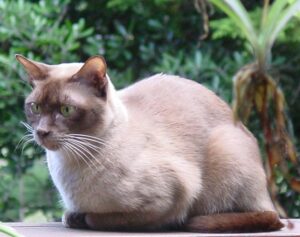Diabetes in Cats
A cat is a carnivore – like many human children, they don’t like vegetables!
Feline Diabetes is usually as a result of insulin resistance – IE; there is a “fortune” of insulin produced; an over production on insulin, the pancreas Islet cells are hyperactive , and it leads to Islet “exhaustion” or depletion as they try to maintain normal blood glucose. This somehow results in pancreatic islet damage, variably reversible, and eventual insulin deficiency. There is also a genetic predisposition to Feline Diabetes.. Eventually the diabetic cats loose insulin secreting capacity.
Causes of feline diabetes include obesity, and any disease increasing cortisol or catecholamine release etc. the majority of diabetic cats are chronically over weight .
Other causes of diabetes in cats are estrus, anxiety, altered metabolism with elevated fatty acids, any chronic stressor, and concurrent endocrine disease.

Breeds: Burmese predisposed – Devon and Scottish Rex are not predisposed,
Cats when stressed can get high glucose levels, and we need to differentiate = Diabetic felines, from feline stress hyperglycemia
Typically signs of Cat Diabetus:
- Excessive thirst and urine production.
- Increased apatite
- Weight loss,
- High fasting blood glucose.
If a cat is anorexic and not ketotic probably not feline diabetus..
Treatments of canine and feline diabetes
- Lots of owner patient interaction , and lot of owner effort
- Anxious owners need to chill !!
- About 12.5% of dog and cat patients are euthanized once the diagnosis is made
- About 30% of diabetic dogs and cate are euthanized in the first year.
- Impact of the therapies on the owner’s quality of life – and a lot of effort
- Vets need to manage owner’s expectations –
- WE do not use oral; hypoglycemic agents in dogs !
Treatments of Canine and feline Diabetes Mellitus
- Insulin and Diet
- Caninsulin, or Lente Insulin or a porcine Zinc suspension – insulin glargine
- All insulin last about 8 -16 hours in the dog or cat
- They last for shorter times in cats than dogs than inpeople
- We use twice daily injections – for good control
- Start of treatments for Canine Diabetes : Start with : 0.5 – 0.75 iu/kg/ 12hours of insulin for the dog
- Start of treatments for Feline Diabetes 2-3 iu / cat /12h for a cat (protamine zinc a good first choice for cats)
- Feed a standardized diet fed 12 hourly or at the time of injection or about 1 hour after the injection.
- Send pet’s home as soon as possible.
- Inject in flank on opposite sides morning and night – more reliable absorption than in neck
Feeding the diabetic Cat
- Must be matched with injections
- Insulin lowers blood glucose – the meal raises the blood glucose – we need to match the two!
- A balance for stable blood glucose
- The stomach takes about 45 minutes to empty – most of calories are being absorbed within 45 minutes meal 45 – 90 minutes = don’t feed at the same time
- Caninsulin start working maximally 2-3 hours later
- Feed 60 – 90 minutes after the insulin injection!! For the best effect in getting good diabetic control.
- Feed standardized caloric content and standardized diet – to body weight and metabolism. The Fiber in diet? Does not necessarily improve diabetic control.
What if they don’t eat? Usually do eat – must be something wrong
- Illness or Insulin resistance – call your vet to review the case.
- How close to normal range do we want out Diabetic pet to be? 8 – 12 mmol/l
- Well controlled –may have a blood fructosamine within 15 % of top normal range,
- Cats diet _>lower carbohydrate diet – chicken wings, hills MD
Dogs diet -> what you like consistently, fibre not important
Monitoring the diabetic veterinary patient,
- Blood Glucose curves ideally being done at home – differences between hospital and home glucose curves in about 50% of cases. Stab ear at side. Look at the average blood glucose – and lowest and highest.
- Fructosamine – glucose binding irreversibly to albumin depends on albumin stable concentration and glucose concentration.
- Attaching a glucose reader to the diabetic patient is becoming more common.
Summary
- Twice daily insulin injections
- Diet feed about 1 hour after injections
- Consistent diet
- Home glucose monitoring
- Besides insulin – in a cat – oral hypoglycemic like glipizide 5 mg tabs, may be trialed, twice daily 1 hour before meal takes about 2 weeks to work. Does not work in dogs.

Informative blog post on diabetes in cats. Valuable insights into the symptoms, diagnosis, and management of this condition in feline companions. Appreciate the emphasis on raising awareness and providing guidance for cat owners. Well done in addressing this important topic and promoting the health of our beloved furry friends.